On the front cover: Molecular dynamics involved in DNA compaction

DNA is packaged in the cell nucleus by wrapping around proteins called histones to form chromatin fibers. Nucleosomes, the structural units of these fibers, are formed by wrapping 146 base pairs of DNA around eight histones. Additional histone proteins, known as linker histones, bind to nucleosomes in a 1:1 ratio to form chromatosomes. The study of the dynamics of chromatosome formation carried out by HITS researchers Mehmet Öztürk and Prof. Rebecca Wade (Molecular and Cellular Modeling (MCM) group) together with Vlad Cojocaru (Max Planck Institute for Molecular Biomedicine, Münster) was published in the August issue of Nucleic Acids Research (NAR) with a front cover illustration.
In this study, classical and accelerated molecular dynamics simulations and Brownian dynamics simulations were used to investigate how the linker histone known as H5 binds to nucleosomes. Based on the findings presented, the authors propose that chromatosomes do not have a single defined geometry but multiple ones depending on the dynamic shapes (conformation) of the interacting nucleosome and linker histone. This concept represents an important contribution towards understanding how DNA compacts in the cell nucleus.
The illustration shows, in the upper region, how alternative linker histone conformations (cartoon shapes colored in red and blue) bind to alternative nucleosome conformations (green-yellow surface shapes with a DNA arm in different shades of blue) by a mechanism known as conformational selection. In the lower framed region, an additional mechanism, known as induced fit, is illustrated in which a closed linker histone conformation forms an encounter complex with the nucleosome (left) and converts into an open conformation in the fully bound complex (right). This cover was prepared by Vlad Cojocaru with the molecular visualization program VMD and the graphic editor Inkscape.
Mehmet Ali Öztürk, Georgi V. Pachov, Rebecca C. Wade, Vlad Cojocaru. Conformational selection and dynamic adaptation upon linker histone binding to the nucleosome Nucl. Acids Res. (19 August 2016) 44 (14): 6599–6613.
Publication in the August 19, 2016 issue of Nucleic Acids Research with the front cover image
Scientific Contact:
Prof. Dr. Rebecca Wade
Molecular and Cellular Modeling Group
Heidelberg Institute for Theoretical Studies (HITS)
Phone: +49 6221 – 533 – 247
rebecca.wade@h-its.org
About HITS
HITS, the Heidelberg Institute for Theoretical Studies, was established in 2010 by physicist and SAP co-founder Klaus Tschira (1940-2015) and the Klaus Tschira Foundation as a private, non-profit research institute. HITS conducts basic research in the natural, mathematical, and computer sciences. Major research directions include complex simulations across scales, making sense of data, and enabling science via computational research. Application areas range from molecular biology to astrophysics. An essential characteristic of the Institute is interdisciplinarity, implemented in numerous cross-group and cross-disciplinary projects. The base funding of HITS is provided by the Klaus Tschira Foundation.